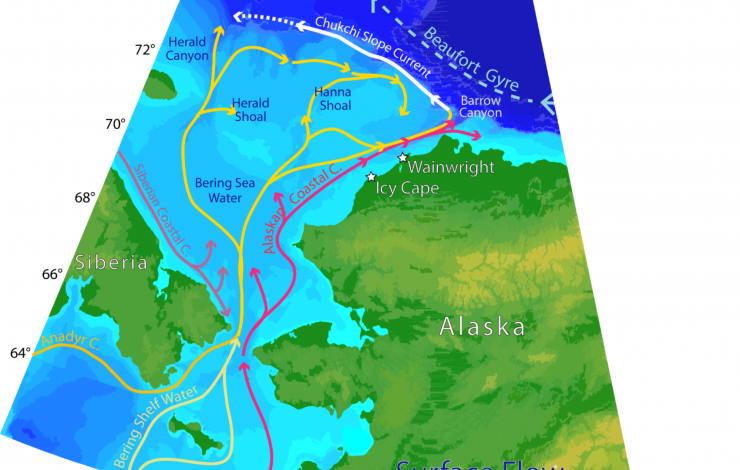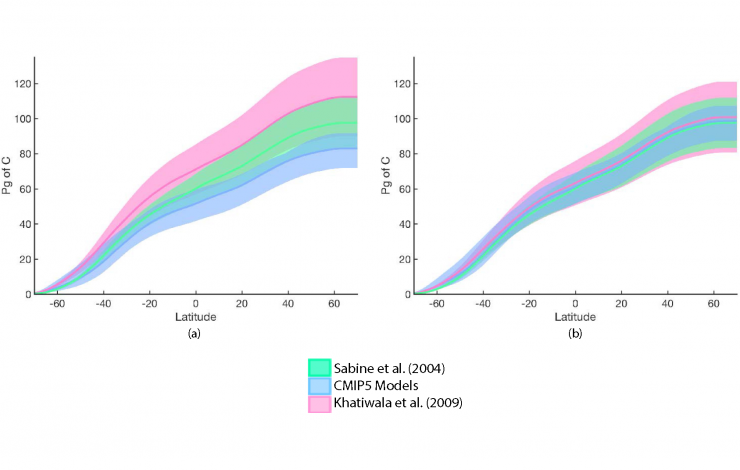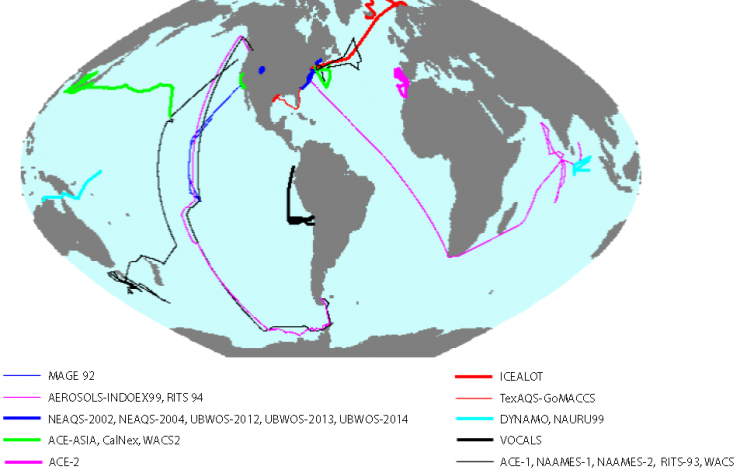Feature Publication Archive

Bathymetric chart of Axial Seamount, located ~5000 ft below the ocean surface and ~250 mi west of Newport, Oregon. Axial Seamount hosts a variety of geophysical sensors that are part of the Ocean Observatory Initiative (OOI) Cabled Array.
Wilcock, W.S.D., R.P. Dziak, M. Tolstoy, W.W. Chadwick, Jr., S.L. Nooner, D.R. Bohnenstiehl, J. Caplan-Auerbach, F. Waldhauser, A.F. Arnulf, C. Baillard, T.-K. Lau, J.H. Haxel, Y.J. Tan, C. Garcia, S. Levy, and M.E. Mann (2018): The recent volcanic history of Axial Seamount: Geophysical insights into past eruption dynamics with an eye toward enhanced observations of future eruptions. Oceanography, 31 (1), 114–123, doi:10.5670/oceanog.2018.117.
Studies of underwater eruptions are essential to understand the processes that form oceanic crust, and the role submarine volcanoes have in exchanging heat and chemicals with the ocean and in supporting chemosynthetic biological communities. The Ocean Observatories Initiative (OOI) Cabled Array at Axial Seamount is the world’s most advanced underwater volcano observatory, building upon 30+ years of sustained geophysical monitoring at this site with autonomous and remote systems as part of PMEL’s New Millennium... more »

Composite map of various branches of the flow in the Chukchi Sea and along the slope.
Stabeno, P., N. Kachel, C. Ladd, and R. Woodgate (2018): Flow patterns in the eastern Chukchi Sea: 2010–2015. J. Geophys. Res., 123(2), 1177–1195, doi:10.1002/2017JC013135.
This paper describes currents in the Chukchi Sea and their relationship to ice and winds. The Chukchi Sea consists of a broad shallow shelf, extending more than 800 km northward from its southern boundary at Bering Strait to the shelf break bounding the Arctic basin. The primary source of water to this shelf is Bering Strait, and much of the flow exits the Chukchi shelf through two canyons—Barrow in the east and Herald in the west. The inflow of Pacific water through Bering Strait provides heat, freshwater, salt, and nutrients to the Arctic Ocean via the Chukchi shelf.
From 2010 to... more »

1995 oceanic anthropogenic carbon content. Integrated with latitude for observational estimates of Khatiwala et al. (2009) in pink, Sabine et al. (2004) in green, and the CMIP5 models in blue, (a) unadjusted, and (b) adjusted relative to 1791 start date. The value at 70°N is the total carbon uptake in the year 1995.
Bronselaer, B., M. Winton, J. Russell, C.L. Sabine, and S. Khatiwala (2017): Agreement of CMIP5 simulated and observed ocean anthropogenic CO2 uptake. Geophys. Res. Lett., 44,doi:10.1002/2017GL074435.
Since the start of the Industrial Revolution, human activity has caused atmospheric CO2 levels to rise. During this time, the ocean has absorbed roughly one third of emitted anthropogenic (human-derived) carbon, so ocean carbon uptake therefore influences how much of this important greenhouse gas remains in the atmosphere. Accurately measuring and simulating ocean carbon storage is important for assessing the current environmental conditions and projecting future climates.
Uncertainties in ocean carbon storage observational estimates are of the order of 25% and generally disagree... more »
,Spectrograms from Axial instrument illustrating the 2 primary song sequences observed.
Regional map of the northeast Pacific Ocean showing locations of all instruments used in this study, along with a timeline indicating when they were deployed. At the scale of this map, KENE and KEMF are effectively co-located, but KENE is displayed slightly offset to the north for clarity (AX, Axial; CI, Cascadia Initiative; CZ, COLZA).
Weirathmueller, M.J., K.M. Stafford, W.S.D. Wilcock, R.P. Dziak, and A.M. Tréhu (2017): Spatial and temporal trends in fin whale vocalizations recorded in the NE Pacific Ocean between 2003-2013. PLoS ONE, 12 (10), e0186127, doi:10.1371/journal.pone.0186127.
Fin whales (Balaenoptera physalus) spend most of their lives ranging widely throughout ocean basins and thus can be extremely difficult to study. Nevertheless, understanding the fin whales’ population structure is of particular importance for management and recovery efforts due to their status as endangered under the U.S. Endangered Species Act.
Fin whales produce relatively simple, repeated signals that appear to have not changed significantly over time. The most commonly observed vocalization produced by fin whales—the “20 Hz pulse”—has been recorded throughout the world’... more »

Map of PMEL Atmospheric Chemistry Cruises conducted between 1992 and 2016
Reddington, C.L., K.S. Carslaw, P. Stier, N. Schutgens, H. Coe, D. Liu, J. Allan, J. Browse, K.J. Pringle, L.A. Lee, M. Yoshioka, J.S. Johnson, L.A. Regayre, D.V. Spracklen, G.W. Mann, A. Clarke, M. Hermann, S. Henning, H. Wex, T.B. Kristensen, W.R. Leaitch, U. Pöschl, D. Rose, M.O. Andreae, J. Schmale, Y. Kondo, N. Oshima, J.P. Schwarz, A. Nenes, B. Anderson, G.C. Roberts, J.R. Snider, C. Leck, P.K. Quinn, X. Chi, A. Ding, J.L. Jimenez, and Q. Zhang (2017): The Global Aerosol Synthesis and Science Project (GASSP): Measurements and modeling to reduce uncertainty. Bull. Am. Meteorol. Soc., 98 (9), 1857–1877, doi:10.1175/BAMS-D-15-00317.1.
Quinn, P.K., D.J. Coffman, J.E. Johnson, L.M. Upchurch, and T.S. Bates (2017): Small fraction of marine cloud condensation nuclei made up of sea spray aerosol. Nature Geosci., 10, 674–679, doi:10.1038/ngeo3003.
Atmospheric aerosol particles affect the Earth’s radiation balance directly by scattering and absorbing incoming solar radiation. In addition, aerosol particles are required for clouds to form. Particles serve as surfaces for water vapor to condense onto which allows droplets to grow large enough to form clouds. The particles that nucleate cloud droplets are called cloud condensation nuclei, or CCN. Through these mechanisms, aerosols lead to changes in regional climate, atmospheric circulation, clouds, and precipitation. Despite the significance of these impacts, aerosols are the... more »


